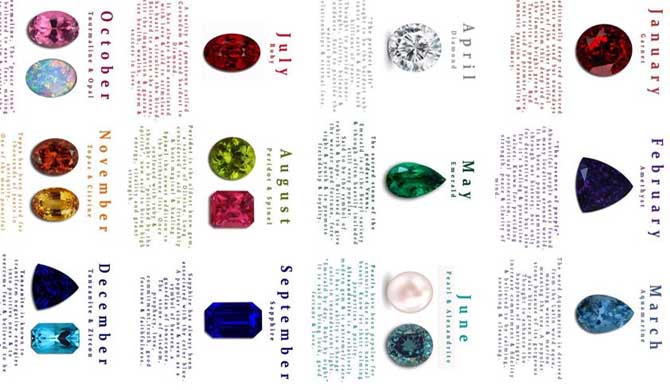
13 Dec The Definitive Guide to Birthstones
There has always been a human “need” to own and wear minerals that have been believed to be sacred or special and this has spurred us to collect them. Perhaps this is the lure to have our birth month represented by a wonderful natural mineral.
Where Did the Idea of Birthstones Come From?
The origin of birthstones is believed to have come from the Breast Plate of Aaron which contained twelve gemstones, each representing the twelve tribes of Israel. Aaron was the brother of Moses. The breast plate was a ceremonial, religious garment worn by the High Priest of the Israelites. The Jewish historian Josephus believed there was a connection between these twelve stones, the twelve months of the year and the twelve signs of the zodiac.
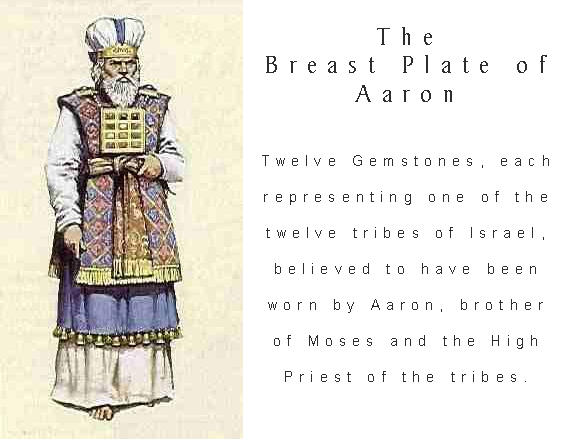

It became practice to own all twelve stones and wear one a month. Wearing only one stone a month is a relatively new concept and there is a difference in opinion as to where it started. George Frederick Kunz, an American mineralogist and mineral collector (1856-1932) believes it started in Poland in the 18th Century whilst the Gemological Institute of America maintain that it started in Germany in the 1560’s.
There is some debate as to which stones were actually in the Breast Plate and as gemstones are now classified by mineral species, these lists vary across the globe. The modern lists have very little to do with the original stones said to be in the Breast Plate and as modern tastes and customs change, so do the stones. Some feel that there is no connection at all and feel that the birthstone list is simply a modern sales ploy.
The current birthstone list dates back to 1912 as a result of the National Association of Jewelers (America) trying to standardize the list. There have since been a number of changes and additions to this list, the most recent being Spinel, added this year (2016) to the month of August and Tanzanite, added in 2002 to the month of December. Some months have several stones allocated to them; a main stone followed by a secondary or tertiary stone. Birthstone lists vary across the globe and some people may feel that other stones should be added or removed.
There are numerous legends and myths about these stones and their healing properties and therapeutic influence. According to these legends, wearing the gemstone during its assigned month is said to heighten its healing properties.
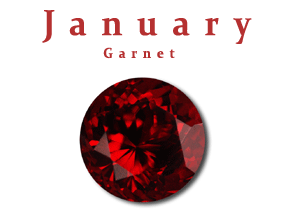
Garnet
Garnet is derived from the Latin word ‘garantum’ meaning “seed”, because the crystals resemble the red color from the pomegranate fruit. Traditionally, the deep red colored Garnet is know as the January birthstone but nowadays any of the beautiful array of colors, from this deep red, to the famous intense green of Kenya’s Tsavorite and the gorgeous “sun burnt” Malaia Garnet from Tanzania are hugely popular, as are the unique purple red of Rhodolite and the majestic, rare Color Change Garnet.
Garnets have been worn in jewelry for centuries; some have been discovered as far back to 2000-1000 B.C. in Sweden, 2300 B.C. in Sumeria and 3100 B.C. in Egypt. Many ancient customs, traditions and beliefs have also formed over the eons, such as the Crusaders believing that they could protect them against accidents during their journeys. Asiatic warriors believed that glowing garnets inflicted more severe wounds when they were used as bullets. In Medieval times it was said that garnets could protect its wearer against bad dreams and poisons, and cured depression, relieved fever, hemorrhages and inflammatory diseases.
Garnet is now said to promote love, romantic passion, sensuality and intimacy. It signifies eternal friendship, trust, loyalty and enduring affections
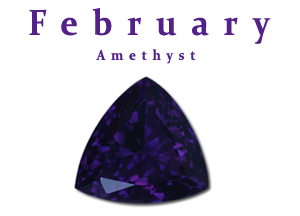
Amethyst
Amethyst is a member of the quartz family and forms as terminated crystals of all sizes in geodes and clusters. It can be found throughout the world and gets its wonderful coloring from impurities of Iron or Manganese compounds. Amethyst is often routinely heated to bring out a deeper purple color. An Amethyst’s color can range from a faint violet/mauve to a rich deep purple.
This beautiful stone has been associated throughout history in many myths, legends and religions. Believed by the ancient Greeks and Romans that it would ward off the intoxicating powers of Bacchus, the Greek god of the wine harvest and making. Ancient Egyptians used Amethyst to guard against fearful and guilty thoughts. In the Middles Ages it was considered as a symbol of royalty and a “cardinal gem”, and used to decorate English regalia. The ancient saint St. Valentine, the patron of love, wore an Amethyst ring carved with a cupid.
It has now become the gemstone know for meditation, peace, courage, inner strength and clarity of mind. Their healing properties include acting as a natural form of stress relief and attract positive energy while ridding your body of any negative emotions. They are said to help strengthen the immune system and heal any imbalances that lie in the body.
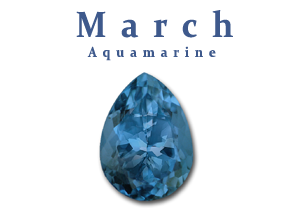
Aquamarine
The word Aquamarine is derived from the Latin word “Aqua”, meaning water and “Marina” meaning the sea. Aquamarine is the blue variety of Beryl, and forms in terminated crystals (six-sided crystals). It’s a popular stone because of its gorgeous pale blue-green tones.
Due to its association to the sea there are many beliefs and traditions. Treasured by mermaids, known as “The Sailors gem” as it was believed to protect sailors from the perils of the sea and guarantee a safe voyage. Said to be sacred to the Roman god of the sea, Neptune. Aquamarine is also linked to the zodiac sign Pisces due to its sea like quality.
Emperor Nero is said to have used it as an eyeglass 2,000 years ago. In Germany Aquamarines were used as glasses to correct short sightedness and the word “brille”, the German name for eyeglasses is derived from the word beryl. It was also considered a stone of eternal youth and happiness.
Today it is still said to protect all who travel by or near the water. Its beautiful serene color is said to be calming, releasing of fear and bringing clarity. Thought to enhance the happiness of marriages, courage, love, hope and good health.
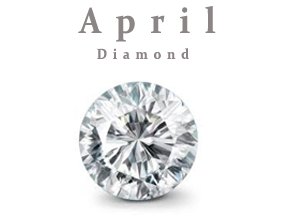
Diamond
Diamond is thought to be the hardest natural mineral on the planet; it’s a form of pure carbon and has be dated back billions of years. Natural Diamond crystals are formed over billions of years at very high temperatures and pressure in the earth’s crust, they are brought to the surface by volcanic eruptions. The word Diamond comes from the Greek unbreakable and they have a very high melting point.
Believed to have been first discovered in India approximately 3000 years ago, Diamonds have been found in alluvial deposits, sedimentary rock, in some samples of Kimberlite (volcanic rock first identified in Kimberley, South Africa) and as tiny flecks inside meteorites. There are many different types of Diamond and they come in an array of colors. The majority of mined Diamonds, approximately 80%, is not suitable for jewelry and is used in industry.
Diamonds have been treasured throughout history, used as religious icons in India, Jewish high priests used them to determine the innocence or guilt of someone accused of a crime. The ancient Romans and Greeks had many beliefs about Diamonds, including that they were the tears of the gods or possibly even splinters that had broken off of falling stars. But by the 1400’s, they were becoming fashionable accessories for Europe’s elite
Know now as a “girl’s best friend”, the ideal gift for a loved one and eternal love. They symbolizes romance, courage and to provide clarity, balance and inner strength.
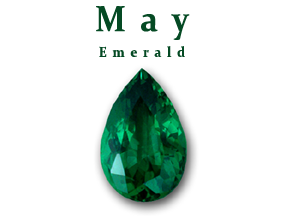
Emerald
Emerald is also a variety of Beryl and probably the most well known variety. It gets its wonderful green color from chromium and vanadium and is frequently found in a form of shale. Today the most famous Emeralds are mined in Colombia.
Though generally very included, it’s a popular gemstone and can be traced back to antiquity. Some of the first Emerald mines were discovered in Egypt dating back to 330 BC. Emerald is thought to be Cleopatra’s favorite gem and the sacred stone of the Roman goddess Venus, the goddess of love and beauty. In the Middle Ages they were believed to hold the power to forecast the future and the early Christians saw them as a symbol of the resurrection of Christ.
Emerald is derived from the Greek word ‘smaragdus’, meaning green and is associated with some of the most beautiful lush green landscapes around the world, Ireland, the Emerald Isle, Washington (US), the Emerald City and even the Emerald Buddha, carved from green jade.
Now known as the symbol of rebirth & hope. Believed to give the wearer good fortune, foresight, health and youth. To promote friendship, faithfulness, wisdom and patience. Traditionally, Emerald has also been known to have magical properties that can keep illness at bay.
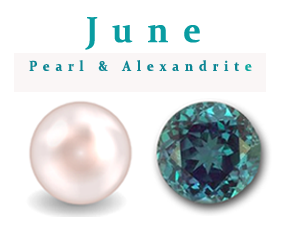
Pearl
Natural and organic, created inside a certain species of mollusk, either in fresh or sea water. Created naturally when a sand particle or fragment of rock is trapped in the shell and irritates the mollusk inside. The mollusk coats the sand particle with many layers of shell material to prevent it from irritating it further. Pearls that have been formed within the tissue of the mollusk its self, rather than in the shell are the most highly revered as these are generally pear or spherical shaped. The color of the Pearl depends on environmental aspects and the type of mollusk.
Cultured Pearls are now more frequently seen on the market, Japanese Mikimoto Pearls being the most famous. Cultured Pearls are produced when an irritant is introduced into the mollusk and then allowed to grow in beds of mesh bags in farms (Periculture).
For centuries Pearls have been worn as an adornment, early Chinese myths told of Pearls falling from the sky when dragons fought and ancient legends tell of them being the tears of the gods. The Ancient Greeks believed that wearing them would uphold marital happiness.
Now used for their calming properties and purity, considered to offer the power of love, protection and luck. Thought to give wisdom through experience and strengthen love.
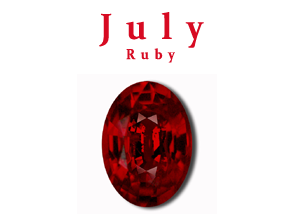
Ruby
Ruby is one of the most highly prized minerals; they command the highest price per carat than any other colored gemstone. It is second hardest to Diamond and is of the gem variety corundum, as is Sapphire. Red corundum is Ruby and all the other colors are Sapphire. All natural Rubies contain natural imperfections called “silk”, this distinguishes them from synthetic stones. Rubies are often routinely heated to improve there their color.
The Mogok Valley in Burma was the main source of fine, rare pieces producing the famous “pigeon’s blood” Rubies. Thailand is another known area for producing fine rubies and both Thailand and Burma regard them as their national stone. Other main areas of Ruby deposits are East Africa.
Its name is derived from the Latin “ruber,” meaning red. This was once used to describe all red colored stones, including Spinel, red Tourmaline and red Garnet causing much confusion in the gem history, and why many famous Rubies have since been re-classified not to be Rubies after all.
Rubies have many legends and myths associated to them. The Ancient Hindus referred to them as “the king of gems”, Greek legends tells a story about a Ruby given to Heraclea during childbirth by the female stork as a token of her kindness. In the Middle Ages, they were believed to bring good health, guard against wicked thoughts and amorous desires and along with other types of red stones, were said to cure bleeding. They were used by royalty to repel evil because it was believed to have magical powers, getting darker in color in the presence of evil.
Ruby has always been associated with love and is known to increase devotion, integrity and happiness. It is said to stir the blood and stimulate the heart, arouse the senses, increase imagination, guarantee health, wealth and wisdom.
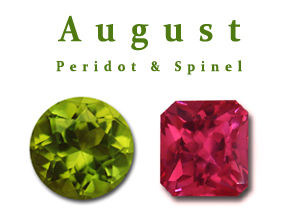
Peridot
Known as one of the oldest known gemstones, Peridot is a variety of olivine, a mineral composed of magnesium iron silicates and is found deep in peridotite rock from the earth’s upper mantle and brought to the surface during volcanic eruptions. Some Peridot has been seen in meteorites. It is derived from the Arabic word faridat, meaning gem and is one of the few gemstones that are found with a narrow color range. Peridot was once known as Chrysolite, a word used for some other colors of topaz, as it was once difficult to accurately identify gemstones.
First mined by the Ancient Egyptians on the island of Zabargad (St John’s) in the Red Sea and know to them as the “gem of the sun”, some believed that it would protect them from “terrors of the night”. The Greeks believed that it brought royal dignity upon its wearer and during the Middle Ages it was thought to ward off evil spirits.
Long been considered to be an aid to friendship and free the mind of envious thoughts and to protect the wearer from evil. Said to host magical powers and healing properties, to bring the wearer power, promote abundance and prosperity.
Spinel
The newest gemstone to be added to the birthstone list, added only this year (2016). A favorite among dealers and collectors due to its wonderful brilliance, hardness and wide range of stunning colors. Known mainly for its beautiful vivid reds, but it can be found in many gorgeous pastel shades and hues, pink Spinel is traditionally the color for August.
Spinel has a similar structure to Ruby and is found in many of the same locations, and they both get their reddish color from impurities of chromium. All this has lead to great confusion in gemstone history as they have often been confused with Ruby and know as Balas Rubis.
In Burma they believe that because Spinel is so perfect, they refer to is as “Nat Thwe” or “polished by the spirits”. In Ancient times some mines produced exceptionally large crystals, and these were treasured by kings and emperors.
Spinel is known as a stone that can bring high energy, vitality and grant strength. Used in the mental realm for intellectual power and aid in reducing forgetfulness.
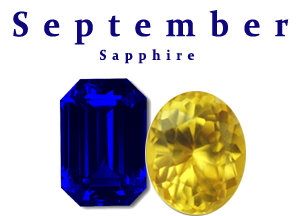
Sapphire
Like Ruby, Sapphire is a form of corundum and though traditionally, blue Sapphires have been associated with the September birthstone, any of the other fabulous colors, the Fancy Sapphires, are now being used. The Padparadscha Sapphire, a very rare and valuable pinkish orange named after the lotus blossom for example, and the fabulous natural Yellow Sapphires from East Africa.
Traditionally even in folklore, history and art, Sapphire has always been associated with the color blue. Sapphire has always been a popular stone, seen as a symbol of heaven and a guardian of innocence, a sign of nobility that has decorated fine robes, rings and brooches of royalty for centuries. Worn by priests as protection from impure thoughts and temptation, it was believed that the stone’s color would darken if worn by an adulterer/ess.
Said now to be the stone of wisdom and prophecy, spiritual insight and good fortune. The stone of love and commitment, truth, sincerity and faithfulness.
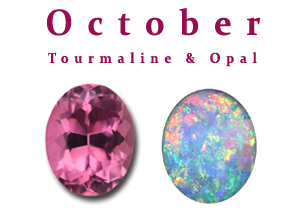
Tourmaline
Tourmaline is a truly fascinating stone. One of the only gemstones that exhibits the broadest spectrum of colors, occurring in various shades of virtually every hue, it can even be bi- or tri-colored like the world famous “watermelon” Tourmaline from Brazil, making it one of the most popular stones. As there are so many different colors, different names have been given to the most popular, for example, Rubellite for red,/purplish red, Chrome for intense green, Savannah for yellowish browns, Paraíba for the spectacular blue tourmaline from Paraíba, Brazil.
Tourmaline has five of its own species and gemologists use the gems properties and chemical composition to define the specific species. Tourmailne is a complex silicate that contains boron and usually forms in “pencils” within granite and can be found in East African Tourmaline . Afghanistan, Sri Lanka, Greenland, Mozambique, Nigeria, Burma, Russia, India, Brazil, Madagascar, Italy and parts of the US.
Some Tourmaline especially the pink to red colored stones are routinely heated to improve their color and it’s these pink Tourmaline that are usually associated with the October birthstone. Tourmaline also have another fascinating property in that they are pyroelectric, meaning that they become electrically charged when heated or rubbed and can attract small objects like dust or lint. Similarly, if they are squeezed or put under pressure – piezoelectric.
As Tourmaline is a relatively new discovery there is not much lore associated with them however, it is known as the “peace stone” and believed to ease fear, making its wearer calm and carries the virtue of unconditional love and friendship.
Opal
A very distinctive stone, derived from the Greek Opallos meaning “to see a change (in color)” as its unique display of changing colors flash as you move the stone around (play-of-color.)
Opal is a hydrated form of silica formed thousands of years ago when percolated rain water, carrying dissolved silica is trapped in cracks within the rock. It then evaporates leaving only the silica, this hardens and through the natural forces of molding and pressure forms into Opals. Opals are amorphous, meaning, it has no crystal structure and they contain up to 20% water trapped within their structure.
Opals are divided into five main categories, White, Black, Fire, Boulder and Crystal. They are found mainly in Australia but also Mexico, parts of the US, Brazil, Canada and Ethiopia.
Opals were greatly valued by the Romans as they thought it was the most powerful and precious gem of them all as they contain all the colors of the other gems and was said to grant the power of invisibility if wrapped in a bay leaf and held in the hand. Ancient monarchs valued them for their protective powers to ward off evil, in the Middle Ages it was believed an Opal would guarantee that the blonde hair of maidens would not fade or become darker. The ancient Greeks believed that they held the gift of prophecy and Arabic legends tell of them falling from the sky during thunderstorms and containing lightning. Unfortunately, they have had a reputation of bringing bad luck, but not through any ancient myth or belief, but from the superstitions espoused in the novel Anne of Geierstein by Sir Walter Scott.
Opal has always been associated with love, passion and desire, it intensifies ones emotional state and releases inhibitions and acts as an emotional stabilizer. It is said to bring out loyalty and faithfulness.
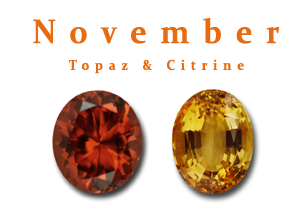
Topaz
Orange Topaz is the traditional November birthstone but as with many other gems, Topaz comes in a myriad of colors and hues. Topaz is an aluminum silicate and is the hardest of the silicate minerals. It is pleochroic meaning that it can show different colors in different directions.
Topaz comes from the old Greek name for a small island in the Red Sea, Topzios, now Zabargad (St. John’s Island). The island never actually produced Topaz but once was the source of Peridot, which was has been confused with Topaz in the past before modern mineralogy reclassified it.
Prized for thousands of years in antiquity. Highly valued by the ancient Greeks and Romans, the symbol of Ra, The Egyptian Sun God and one of the sacred stones of the Hindu Kalpa tree and in their mythology topaz means heat. In India, it was believed that if a Topaz was worn above ones heart would guarantee intelligence, long life and beauty. During the Renaissance in Europe people believed that a Topaz could break evil spells.
It has always been believed to be one of the most powerful gemstones in the healing sense, as it said to balance the emotions and provide protection against greed. It is also the symbol of friendship, love and affection.
Citrine
Another member of the Quartz family, natural Citrine is actually very rare, most is heat treated Amethyst. The name is derived from the Latin word Citrine which means yellow and is thought to be the origin of the word “citron”. Before modern mineralogy, Citrine was often confused with Topaz. Citrine is found in a variety of different shades and is one of the most popular yellow gemstones.
Known in the past as the as the “merchant’s stone” as it was believed to bring prosperity, and like all other Quartz believed to have magical powers to protect against evil. It was used by the ancient Romans for jewelry and intaglio work. It was an extremely popular stone for jewelry during the 19th Century Art Deco period when it was considered extremely rare.
Known as the “healing quartz” and used to purify the system, support vitality and health, to help counteract the toxic effects of many pharmaceutical medicines, as well as guiding energy, warmth and hope.
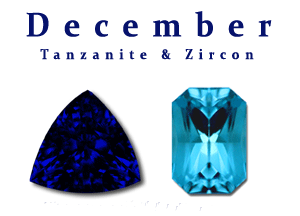
Tanzanite
Tanzanite is part of mineral species Zoisite and comes in a wonderful range of blues and violets. It was discovered in the Merelani Hills, Tanzania in 1967 by a local Maasai tribesman and as yet has not been discovered in any other part of the world. Named by Tiffany & Co after the country of its discovery, Tanzanite was the first gem to named to the birthstone list in over 100 years when it was made the birthstone for December in 2002.
Naturally Tanzanite is a brown treacle colored crystal, it is routinely heated to bring out its wonderful colors. Tanzanite has an amazing property called trichroism, meaning that one can see different colors depending on which axis (angle) to you look at the stone. Tanzanite has three main colors, violet, blue, and reddish/brown. The reddish/brown color is removed during the heating process and then it is cut at a certain angle to bring out more of the blue or the purple axis. It is also this Trichroism that is responsible for the way Tanzanite behaves under different lighting conditions; known also as the “mood changer” because Tanzanite can appear a totally different color under different lighting. In day light (white light) Tanzanite will be bluer and in incandescent (yellow light) more purple, it is also in the yellow light that Tanzanites famous “red flash” is more visible.
Because Tanzanite was only recently discovered there is not much history or lore behind them but they are now known for various healing properties. They are said to be very helpful in all stress related illnesses and transform negative energies into positive ones and know to overcome fear and anxiety. They are said to be very magical stones and may connect you with ancient wisdom, they are known to be excellent in meditation as they can increase spiritual awareness and some say they are a very creative stone.
Blue Zircon
Zircon is the oldest mineral on earth, 4.4 billion years old! It forms in many different types of rocks and is found in manly locations around the world but most production is from Australia. Zircon comes in a variety of different colors but it is the blue Zircon that represents the month of December, most blue Zircon is heated.
Colorless Zircon has often been confused with Diamond and more recently Cubic Zirconia due to its brilliance and wonderful flashes of multicolored light. Zircon is a relatively brittle stone but is still highly valued because of its beauty and stunning colors. Some Zircon is damaged by radioactive elements over long periods of time but it is the high quality Zircon that is used in jewelry.
There is no real history behind Zircon or any legends but they have been used for centuries mainly for their healing properties. In the Middle Ages they were used to guard against the Black Death, the great plague of Europe and were thought to induce sleep, prevent nightmares and to promote honor, wisdom and prosperity. Green Zircon is used to represent the foliage of the Hindu “Kapla Tree”.
Nowadays Zircon is believed to increase one’s self confidence and motivation and to provide guidance. It is said to possess a strong magnetic force and have an intense healing energy that is highly spiritual and help balance ones virtuous aspects.

